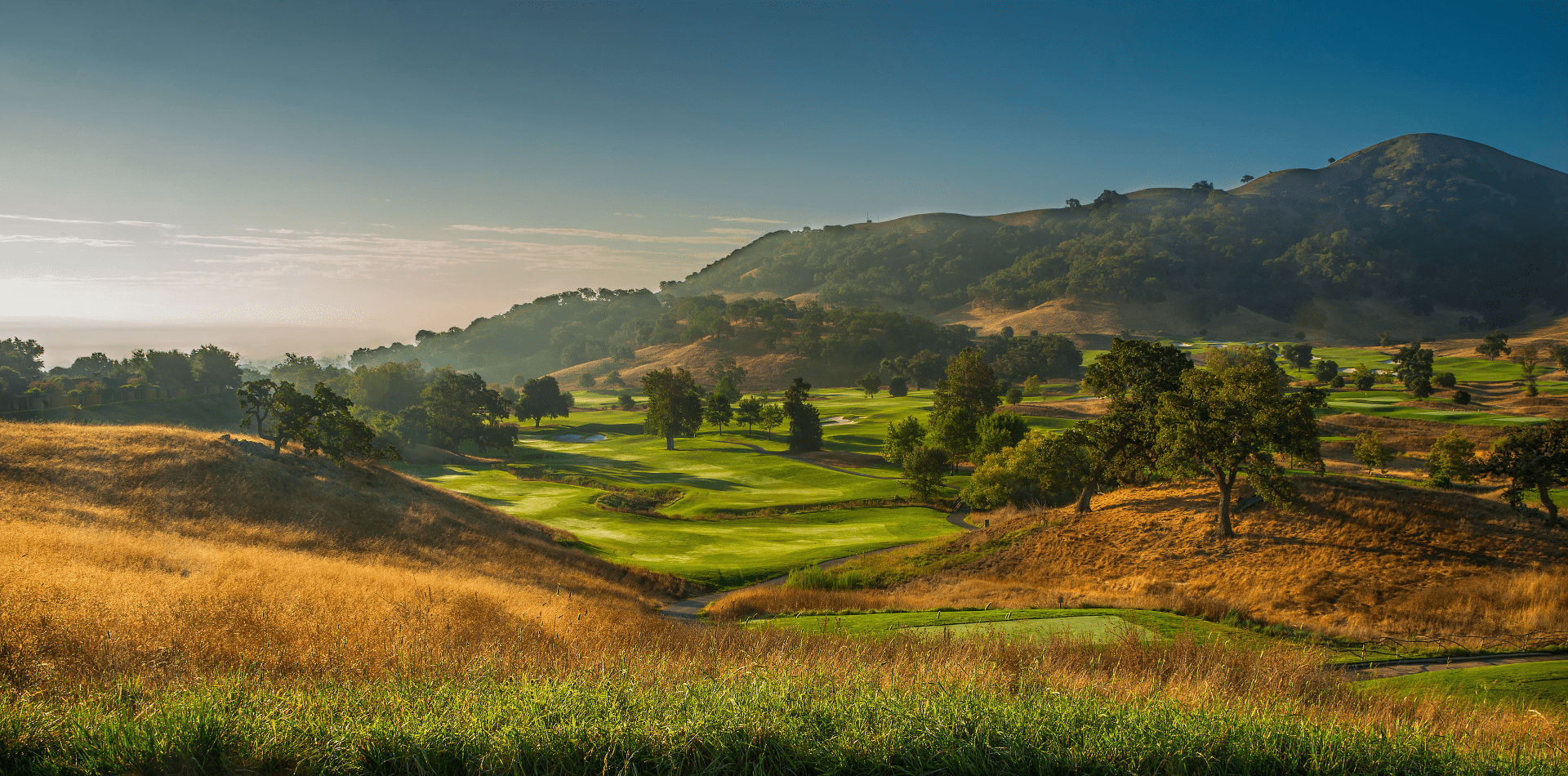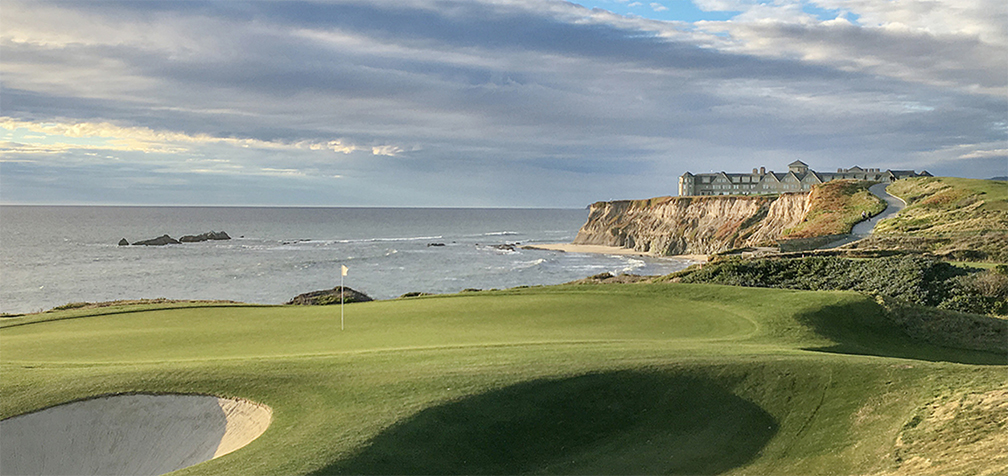
CordeValle
Much of the attention from golfers travelling to Northern California is centered on the outstanding resort courses at Pebble Beach, or on the Bayonet and Black Horse courses at Fort Ord, or on the tracks they might see on television that are used by the PGA Tour and PGA Tour Champions such as TPC Harding Park and the Silverado Resort in Napa Valley.
But there are other great and public courses a little more off the beaten path in Northern California, in remote locations such as San Martin, Half-Moon Bay and Livermore, each of which is no more than a 90-minute drive from the Golden Gate Bridge.
We teed it up at a handful of these “other” courses and resorts on a recent journey to the region, playing the finer-than-fine course at CordeValle, the two courses at the uber-swanky Half-Moon Bay Resort, and two tracks east of the immediate Bay Area, at Poppy Ridge and Wente Vineyards.
When we left, we carried two questions home with us – does anybody realize how good these courses are, and when can we go back?

Half Moon Bay
CordeValle is peerless and wonderful
You might have heard about CordeValle, the luxury golf resort set about a half-hour’s drive southeast of San Jose in the town of San Martin and smack tab in the middle of northern California’s wine country. Maybe you’ve even seen some video of the lush destination on television or in a golf magazine or in your dreams.
We ask that you put everything aside that you’ve heard or seen and understand that this place is even better than its reviews. Our team has stayed at some of the finest golf resorts and played some of the best courses in the world, and CordeValle without a doubt gets our seal of approval.
CordeValle has received kudos, and rightfully so, for being the most romantic getaway in the region. Those that are lucky enough to stay here can enjoy the resort’s 5,000-square foot world-class spa, a winery and vineyard right next door and its tennis center as well as three dining venues.
Then there’s the Robert Trent Jones Jr.-designed golf course that’s plenty good enough to put a charge into the best golfers in the world, as evidenced by its heralded run as the host track for the Women’s U.S. Open in 2016.
The golf course is a 7,360-yard, par-72, award-winning golf track was fashioned by Jones, Jr. to offer excitement and enjoyment to both the passionate and novice golfer. Many believe that the course at CordeValle is the internationally acclaimed golf architect’s finest work, and after playing 27 holes in one afternoon (all that the day’s sunlight would allow), it’s a claim that is certainly justified.
Situated on 270 acres of gently rolling terrain in a pastoral California valley, the routing utilizes the natural elevation changes of its peaks and canyons, enhanced by broad meadows, streams, and striking sycamore and oak trees.
Allowing for multiple tees and approaching angles for varying degrees of difficulty, the course takes on new dimensions every time it is played. An elevation change of approximately 150 feet over the entire 18 holes also makes it walkable for the golf purist and demands different strategies and club selections throughout.
There’s a drivable par-4, the eighth, which is attacked over water for those willing to risk the high number. The finishing stretch is particularly stout and features two risk-reward par 5s (the 15th and 18th). The last hole has water that comes into play often, including a large pond left of the green that may or may not have claimed one of our golf balls after getting a little too aggressive here so beware.
Along with the Women’s U.S. Open in 2016, CordeValle has hosted the likes of the PGA Tour’s Frys.com Open from 2010-13, the 2011 and 2015 PGA Cup and the 2013 USGA Senior Women’s Amateur Championship.
CordeValle features its own over-the-top art collection strategically placed throughout the property. Lodging is offered in a mix of 45 bungalows, fairway homes or villa suites and is peerless, roomy and comfortable in every way.

CordeValle
Two courses at Half Moon Bay couldn’t be more different
There are times when you walk the pair of splendid golf courses at the Half Moon Bay Resort that you’d swear you’re playing either a seaside links in Scotland or a parkland track on the outskirts of London.
Maybe it’s the chill of the misty air when you’re along the bluffs of the Pacific Ocean as you tackle the meat of the Ocean Course on the resort’s southern side.
Or perhaps it’s the way that lush trees and vegetation, and flawless conditioning, direct you around the inland holes of Half Moon Bay’s Old Course, right up until you stride up the hill behind the 16th green and the sight of the endless view of the Pacific hits you right between the eyes as you prepare to play the par-3 17th with the ocean as your backdrop.
Half Moon Bay Resort is regally set on the California coastline, equidistant from San Francisco and the Silicon Valley. Set on the bluffs of the Pacific, just 19 miles from San Francisco International Airport and 45 minutes from San Jose International Airport, this enclave – home to Half Moon Bay Golf Links’ two courses and The Ritz-Carlton, Half Moon Bay – radiates stately ambiance with a Georgian revival estate and 36 holes of oceanfront golf.
The joy of being here is in taking in the total package and making this place your own. First there’s the drive down the California coastline from the Golden Gate or past cypress- and pine-covered hills on the way over from the Silicon Valley. Once in the town of Half Moon Bay, there’s the push out onto the ledge of the Pacific onto the resort property with its striking hotel hanging above the water.
Then it’s up to each one of us to figure out how many layers of clothes to wear in dealing with Half Moon Bay’s microclimate, an effect that will have golfer in short sleeves one minute, down vests and rain suits an hour later and running for a spot near the resort’s fire pits as soon as the round is done.
Designed by Arnold Palmer and Francis Duane and opened in 1973, the Old Course is an American classic whose lush parkland-links routing features 7,001 yards of challenge, distinguishing edges and corridor views of the Pacific.
The Old Course finishes at one of the highest ranked holes in the world – the 405-yard par-4 18th, which culminates on a bluff with dazzling coastal vistas at the base of the hotel. It has played host to numerous U.S. Open Qualifiers and demands strength, especially off the tee, and will test all facets of your game.
Where the Old Course is somewhat protected from the elements through its first 16 holes, the Ocean Course is totally exposed to the whims of Mother Nature. Perched on a bluff high above the roaring Pacific, the Ocean Course boasts sea views at every turn and quartet of holes that finish the round that are considered among the finest on the Pacific Coast.
Opened in 1997, and designed by renowned architect Arthur Hills, the Ocean Course delivers “firm and fast” fairways, with wispy native grasses accenting the tees joining forces to transport players and guests alike back to the game’s Old World origins.
It would be easy to say that the golf experience at Half Moon Bay is spectacular, but, to be honest, that term just doesn’t do it justice.

Half Moon Bay’s Ocean Course
Poppy Ridge is three times as good
The trip north and east across the Bay Bridge, through Oakland and over the mountain ridge on that city’s eastern confides is memorable in its own right. So a round at Poppy Ridge Golf Course, in Livermore, has a lot to live up to – and it passed the test with flying colors.
This course rests in the foothills just west of Altamont and is the sister track to the Poppy Hills course in Pebble Beach. Poppy Ridge is second facility belonging to the Northern California Golf Association.
Poppy Ridge, opened in 1996, named its three Rees Jones–designed nines after grape varietals: Merlot, Chardonnay, and Zinfandel. Each nine ends in front of the facility’s hacienda-style clubhouse, which serves champagne brunch at its restaurant every weekend.
Each of the nines play at between 3,500-3,600 yards from the back tees and there is nearly 300 feet of elevation change between the trio.
Many players believe the Merlot course is the most difficult because it’s on the highest ground and most exposed to the winds that whip across the site. The greens are kept speedy and true and can be very difficult to read.
The Chardonnay nine appears to be more benign, but isn’t as water, sand, bogs, trees or shrubs or fences and combination of the above to deal with on virtually every hole.
Miles and miles of vineyards with the winter post and wire stitched in patterns across softly undulating hills surround the course, producing amazing vistas. You certainly know where you are playing.
Norman draws on Australian roots at Wente Vineyards
Our final stop on the trip was at the lush Course at Wente Vineyards, also in Livermore. Over the 24-odd years since its opening, the Greg Norman design has matured as nicely as the fine wines that share the facility’s acreage. The site is in the midst of hay-colored hills and working vineyards come into play on a handful of holes here.
The 18-hole championship course is a picturesque 7,181-yard, par-72 upscale (and then some) daily-fee golf facility opened in July 1998. The architect made use of three distinct topographies here: native woodlands (some of them are sycamores), mature vineyards and rolling hills of natural grasslands.
Norman also stayed true to his roots by positioning Down Under-influenced Sandbelt-style bunkering throughout the routing to add beauty and menace to the round.
Golfers will be faced with dramatic elevation changes that can produce some uneven lies. The flip side of that aspect is that Wente Vineyards offers panoramic views to be enjoyed on almost every hole. The fairways and landing areas are narrow and require good club management. The prevailing winds add another challenging element to the course.
The Course at Wente Vineyards’ back nine holes are more demanding with the par 3s being especially memorable. The amphitheater-like par-5 fifth, framed by mountains and grape vines, is a standout.
For the better golfer, the Course at Wente Vineyards isn’t intimidating as much as it is a true challenge. Misread slopes on massive greens make for three putts and missed approaches create demanding up-and-downs. But for all golfers, the course is a true delight for its overall presentation and dynamite views and conditioning and a wonderful addition to any visit to the area.

